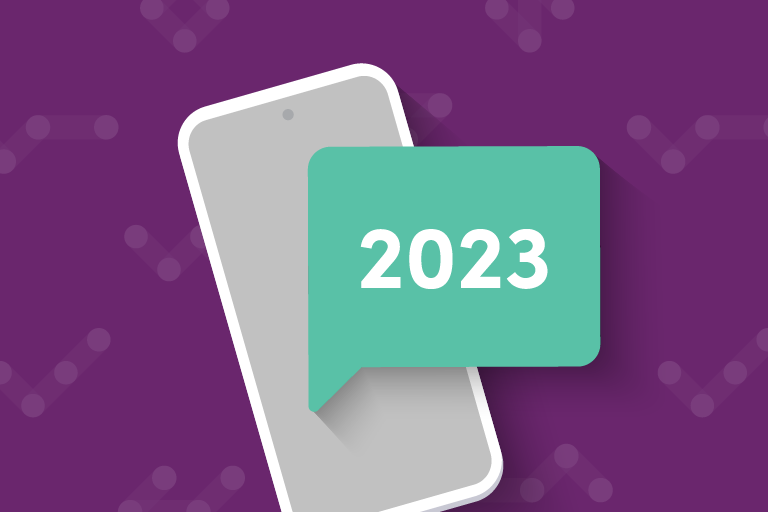We recently reviewed 2023 from an email marketing perspective and, while email marketing is certainly a powerful marketing channel, mobile marketing is nothing to overlook. So, as we reach the end of 2023, we wanted to take a glance back at all that’s happened over the past 12 months. Specifically, this time, we want to take a closer look at mobile marketing.
We perused the content we published in the past year and gathered resources from across the web to compile a list of the biggest mobile marketing changes we saw in the last year. These changes, like those changes in email marketing, aren’t going anywhere, so let’s get to it.
1. Automation
Yep, automation is on the mobile marketing list too. Mobile marketing channels like SMS and push notifications can be highly effective (SMS, for example, has a 98% average open rate), but marketers are hesitant to include them in their overall marketing strategies. There’s a misconception about how difficult these channels are to implement.
Mobile marketing automation, however, makes a world of difference. The right mobile marketing platform will have the following features built in:
- SMS smart opt-in that allows users to confirm their written consent in just a click
- Phone verification for enhanced security and list hygiene
- Configurable quiet hours to comply with regulations and retain brand trust
- Verified contact cards that users can add to their contacts for improved deliverability
- Frequency capping to limit the number of texts (and other message types!) a user can receive within a certain duration
- Opt-out attribution for automated tracking for every SMS campaign
2. Operating System Updates
When Apple or Android release new operating system updates, it tends to shake things up in the mobile marketing world. But, these updates are meant to benefit the end user which, at the end of the day, makes the overall customer experience better. In August of this past year we covered iOS17—specifically the link tracking update.
As stated in our August post: “With this new release, Apple announced Link Tracking Protection which, in a couple of key scenarios, will strip away the parts of the URL that Apple identifies as tracking parameters.
The good news, however, is that “at this point, Iterable’s links don’t seem to be impacted by this update. So, if a customer opens an Iterable link via Apple Mail, for example, Iterable’s tracking parameters are still intact and Iterable customers can still see click metrics.”
3. Gamification
It’s no secret that games are fun. So, when trying to engage customers through mobile channels, gamifying the experience helps make the experience more interactive. In our June article, Top 5 Strategies to Successfully Grow Your App User Base, we specifically mentioned push notifications and in-app messages.
We shared, “Now that you’ve optimized for the app store and acquired high-value users, it’s time to encourage customer engagement to drive actions within your app. When it comes to engaging and re-engaging users, two of the greatest channels at your disposal are push notifications and in-app messaging.”
What does this all mean? Consider how you can make the experience more playful to engage users while you have their attention (i.e., when they’re already engaging with your app). Take loyalty programs, for example. Maybe you offer points towards rewards if customers complete certain actions within your mobile app. Or, maybe it’s as simple as completing levels in a learning app and making strides towards an overall goal. Get creative with it!
4. Cross-Channel
You knew it was coming. Cross-channel is incredibly important when thinking about mobile marketing. What’s special about mobile marketing is that there’s an inherent link between users’ phones and the real world. Because people carry their phones with them everywhere, there’s the unique opportunity to link physical channels to mobile channels.
One way brands can connect the physical and the digital (aka phygital) is through QR codes. In our article from November we wrote, “QR codes are especially helpful in bridging the gap between digital and physical when it comes to retail. While shopping, customers can use QR codes to gather more product information, add the product to their digital shopping carts, or even get digital coupons.”
Customers always have their phones on them, so think of ways to use this to your brand’s advantage. Offer them multiple ways to connect with your brand—both online and offline—while simultaneously creating a seamless experience.
5. Mobile KPIs
Integrating mobile channels into your cross-channel marketing strategy requires an understanding of what success looks like. But, to measure success you need to define KPIs. Luckily a lot of the metrics we know and love—open rate, click-through rate, etc.—translate from email to mobile channels. But, there are also some new metrics to consider.
Because SMS regulations require customers to opt in to receive communications (and also require brands provide customers the option to opt out), metrics like opt-in rate and opt-out rate will be important to keep an eye on. A good opt-out rate, for example, is below 5%.
It’s not just SMS metrics you need to keep an eye on. With push notifications, for example, customers have to enable notifications from your brand to even see the messages you’re crafting. Consider how many customers are allowing notifications and keep an eye on that metric to ensure your messaging is engaging and relevant to your app users.
What a Year It’s Been
Mobile channels (SMS, push, and in-app) have solidified their spots in the group of necessary marketing channels. We’ll have some 2024 predictions regarding upcoming mobile marketing trends early next year—maybe even some new channels—but it’s important to take time to reflect, level-set, and understand the changes that have emerged in 2023 to set yourself and your team up for greatness in the coming year.
With automation, operating system updates, gamification, cross-channel, and mobile KPIs taking a front seat, the way mobile marketing programs are designed going forward will need to take all of these elements into consideration. Luckily, these changes benefit both marketers and customers, and only help to create a holistic, consistent customer experience.
To learn more about how Iterable can help you achieve your mobile marketing goals in 2024, schedule a demo today.



























